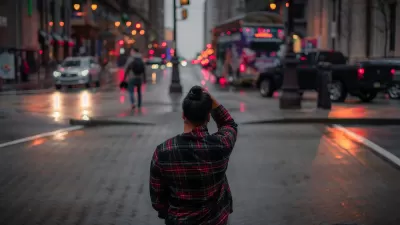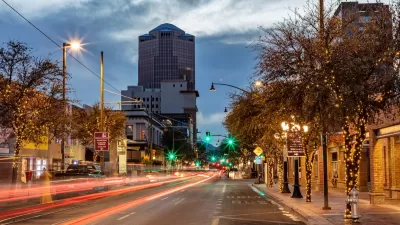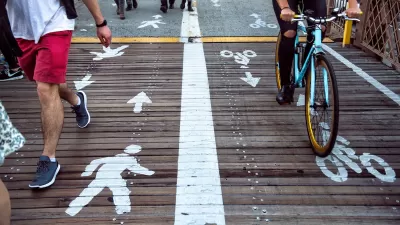American pedestrians are moving faster and spending less time connecting with other people when walking down city streets.

American pedestrians are spending less time hanging out on sidewalks and streets, according to a new study from the National Bureau of Economic Research.
As David Zipper explains in Bloomberg CityLab, the researchers used artificial intelligence to analyze video footage from 1980 and 2010, noticing that people walk faster and spent less time interacting than they used to. “They seemed to be having fewer of the informal encounters that undergird civil society and strengthen urban economies.”
While the analysis doesn’t explain why behavior patterns have changed, the researchers offered several possible explanations. “City dwellers might be having fewer social interactions of all kinds, a phenomenon that has been linked to rising rates of loneliness. And some of the pedestrians observed in 2010 could have been socializing remotely: By then, 80% of US adults had cellphones.”
People may also be using more commercial third spaces like coffee shops and bars to socialize, particularly in places where public space is not comfortable or inviting. This leads to people spending more time around people who are similar to them, sharing similar economic backgrounds and experiences.
For the researchers, the shift is troubling. “Beyond creating personal connections, human exchange fuels economic productivity as people figure out how to do their job more efficiently or find inspiration for a new venture. Benefits reverberate citywide, and even across society writ large.”
FULL STORY: What Happened to Hanging Out on the Street?

Planetizen Federal Action Tracker
A weekly monitor of how Trump’s orders and actions are impacting planners and planning in America.

Congressman Proposes Bill to Rename DC Metro “Trump Train”
The Make Autorail Great Again Act would withhold federal funding to the system until the Washington Metropolitan Area Transit Authority (WMATA), rebrands as the Washington Metropolitan Authority for Greater Access (WMAGA).

The Simple Legislative Tool Transforming Vacant Downtowns
In California, Michigan and Georgia, an easy win is bringing dollars — and delight — back to city centers.

The States Losing Rural Delivery Rooms at an Alarming Pace
In some states, as few as 9% of rural hospitals still deliver babies. As a result, rising pre-term births, no adequate pre-term care and "harrowing" close calls are a growing reality.

The Small South Asian Republic Going all in on EVs
Thanks to one simple policy change less than five years ago, 65% of new cars in this Himalayan country are now electric.

DC Backpedals on Bike Lane Protection, Swaps Barriers for Paint
Citing aesthetic concerns, the city is removing the concrete barriers and flexposts that once separated Arizona Avenue cyclists from motor vehicles.
Urban Design for Planners 1: Software Tools
This six-course series explores essential urban design concepts using open source software and equips planners with the tools they need to participate fully in the urban design process.
Planning for Universal Design
Learn the tools for implementing Universal Design in planning regulations.
Smith Gee Studio
City of Charlotte
City of Camden Redevelopment Agency
City of Astoria
Transportation Research & Education Center (TREC) at Portland State University
US High Speed Rail Association
City of Camden Redevelopment Agency
Municipality of Princeton (NJ)





























